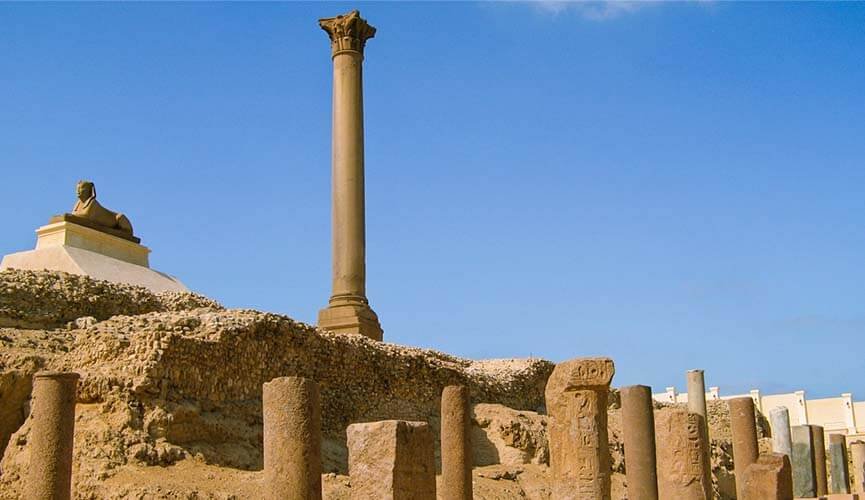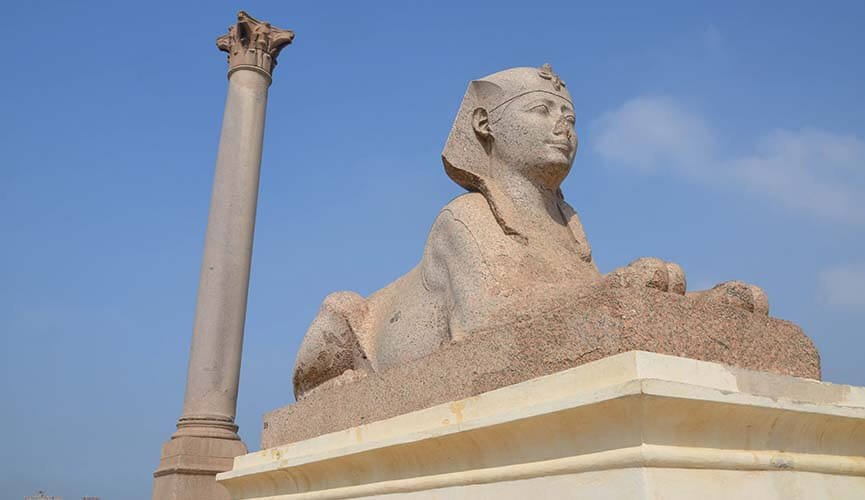Located in the heart of Alexandria, Pompeys Pillar Egypt stands as a testament to the grandeur of ancient Roman engineering and architecture. This towering column, built in 297 AD, is a prominent feature of the city and remains one of Egypt’s most important historical sites. But Pompey’s Pillar is more than just a monument—it’s a symbol of the Roman Empire’s influence and a captivating piece of Egypt’s layered history.
With its incredible height and intricate design, Pompeys Pillar Egypt offers travelers a rare opportunity to step back in time and experience the might of ancient civilizations. In this guide, we’ll explore the fascinating history behind Pompey’s Pillar Egypt, its cultural significance, and what visitors can expect when they explore this iconic landmark.
Choose One of Our Egypt Day Trips or Egypt Packages Through Khufu Egypt Tours & Get 20% OFF
Key Takeaways:
- Pompeys Pillar Egypt is the largest ancient Roman triumphal column still standing in Egypt.
- The pillar stands at a remarkable height of 28 meters (92 feet).
- It was built in honor of Emperor Diocletian in 297 AD.
- The site is located in Alexandria, Egypt, and offers rich historical significance.
- Visitors can explore the ruins of the ancient Serapeum temple near the pillar.
- Pompey’s Pillar is one of the most visited landmarks in Alexandria, attracting history enthusiasts and tourists alike.
- The monument offers stunning panoramic views of the city and the Mediterranean coastline.
The Fascinating History Behind Pompeys Pillar Egypt

Pompey’s Pillar was constructed during the reign of Emperor Diocletian in 297 AD. The column was originally erected to commemorate the emperor’s victory over the rebellious Alexandrians. While its name might suggest a connection to the famous Roman general Pompey, this is a misconception; the pillar was never associated with Pompey the Great.
Instead, the name was likely given during the Middle Ages, a time when local legends often confused historical events. Regardless of the name’s origin, the pillar stands as an impressive relic of Roman architectural skill, symbolizing the empire’s dominance in the region. Its massive height of 28 meters (92 feet) is a striking feature that continues to awe visitors from around the world.
Architecture and Design: A Testament to Roman Engineering
Pompey’s Pillar is constructed from red Aswan granite, a material known for its durability and aesthetic appeal. The column is simple yet elegant, with minimal decoration, which was characteristic of Roman triumphal columns. The structure stands alone today, but it originally would have been part of a larger complex, likely the Serapeum, which housed the remains of the famous Egyptian deity Serapis.
The pillar’s smooth, cylindrical shape rises dramatically above the surrounding ruins, drawing attention from afar. The simplicity of the design contrasts with the grandeur of the Roman Empire, emphasizing the power and authority that the monument represented at the time of its construction
The Serapeum: A Sacred Place of Worship
Pompeys Pillar Egypt is situated near the ruins of the Serapeum, an ancient temple dedicated to the god Serapis. The Serapeum was one of Alexandria’s most important religious sites and a center of worship for the people of Egypt. Although much of the temple has been lost over the centuries, visitors can still explore its remains and gain insight into the religious practices of ancient Egyptians and Romans.
The Serapeum was home to one of the largest libraries in the ancient world, rivaling the famous Library of Alexandria. The temple was also a place of learning and scholarship, attracting intellectuals and philosophers from all corners of the empire.
Today, visitors to Pompey’s Pillar can wander through the ruins of the Serapeum and admire the architectural remnants that once formed the foundation of this great religious institution. The juxtaposition of the pillar and the temple ruins provides a captivating look at the intersection of Roman and Egyptian cultures.
Visiting Pompeys Pillar Egypt: What to Expect

Pompeys Pillar Egypt is one of Alexandria’s most visited historical sites, and it’s easy to see why. The monument’s towering presence is impossible to miss, and the surrounding area offers visitors a chance to experience the ancient city’s unique history.
When you visit Pompey’s Pillar, you’ll find yourself standing at the heart of a site rich with historical significance. From the base of the pillar, you can marvel at the impressive structure and take in the breathtaking views of Alexandria. The site also features other remnants of the ancient city, including parts of the Serapeum and the surrounding ruins, which provide valuable context to the history of the area.
Visitors can take a leisurely stroll around the site, soaking in the ancient atmosphere, or opt for a guided tour to gain deeper insights into the history and significance of Pompey’s Pillar. The experience is both educational and awe-inspiring, offering a rare glimpse into Egypt’s Roman period.
Pompeys Pillar Egypt and Alexandria’s Rich Roman Legacy
Pompey’s Pillar is not the only Roman-era landmark in Alexandria. The city itself was once a thriving metropolis of the Roman Empire, with numerous structures that speak to the might of Rome’s influence. From ancient theaters and baths to temples and catacombs, Alexandria’s Roman legacy is scattered across the city, waiting to be explored.
For those interested in diving deeper into Roman history, Pompey’s Pillar provides a starting point for discovering other significant landmarks in Alexandria, such as the Catacombs of Kom El Shoqafa, the Roman Theater, and the Citadel of Qaitbay. Each of these sites offers a unique perspective on the city’s past and its role in the broader context of ancient civilizations.
Why You Should Visit Pompeys Pillar Egypt
Pompeys Pillar Egypt is more than just a column; it’s a link to Egypt’s past, a reminder of the powerful Roman Empire, and a must-see attraction for history lovers and travelers alike. The monument’s grandeur and historical significance make it one of the standout landmarks in Alexandria.
For visitors to Egypt, a trip to Pompey’s Pillar is an essential experience. Whether you’re a history enthusiast, an architecture aficionado, or simply someone seeking to connect with the past, this site offers something for everyone. And with its central location in Alexandria, it’s an easily accessible destination for travelers exploring the city.
Conclusion
Pompey’s Pillar in Egypt stands as a remarkable testament to the ancient world, offering a glimpse into the country’s rich history. Erected during the reign of Roman Emperor Diocletian, it is one of the tallest ancient monuments still standing in Alexandria. The pillar, originally part of a larger complex, has become a symbol of Roman influence in Egypt.
Despite its name, the monument is not connected to Pompey the Great but rather commemorates the Roman emperor’s victory. Today, it continues to captivate visitors with its impressive size and historical significance, making it a must-see for those interested in Egypt’s diverse cultural heritage.
Read More About Our Related Articles:

